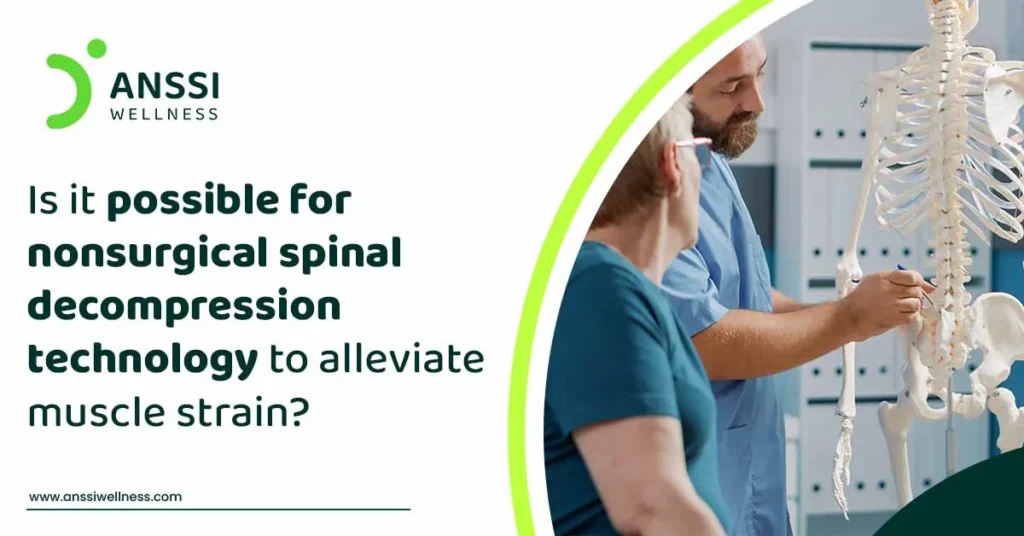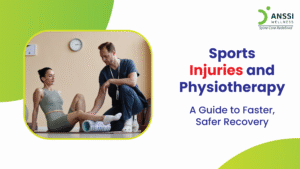Despite the fact that injuries and complications associated with various sports are different, muscle strain is by far the most common sports-related injury. The most common cause of muscle strain, also known as muscle tear or a pulled muscle, is a sudden pressure that causes a muscle to stretch beyond its normal range. Due to the rapid acceleration and deceleration of muscles, the lower back, hamstrings, quadriceps, and gastrocnemius muscles are most susceptible to strain.
Muscle strain can be treated with a variety of methods that aid in pain relief, swelling reduction, and full recovery. One such technology is non-surgical spinal decompression, which your chiropractor may recommend based on your specific requirements. Let’s talk about muscle strain and how non-surgical spinal decompression technology can treat this condition.
What is a Muscle Strain?
When a muscle or tendon is stretched too far or torn, it’s called a strain. It’s also known as a “pulled muscle.” It could cause anything from mild discomfort to severe pain and make your daily life difficult. Pain, swelling, stiffness, a limited range of motion, and bruising are all possible signs of muscle strain.
These are categorised according to their severity:
- Grade 1 strain: The symptoms might not show up until the activity is finished. When muscles are stretched or contracted, there is no loss of strength or movement, but there may be a sensation of muscle tightness, cramps, or slight pain.
- Grade 2 strain: When a muscle is stretched or contracted, there is immediate pain, swelling, decreased strength, and limited movement due to pain.
- Grade 3 strain: This is a very serious injury. Pain that burns makes it impossible for an athlete to walk. A substantial lump of muscle tissue can be seen after the muscle has been completely torn. Pain, swelling, bruising, and complete loss of function occur immediately.
Why Does Muscle Strain Occur?
When a muscle stretches abruptly or more than usual, this is called an acute strain.
The primary causes are as follows:
- A chronic strain occurs when a muscle undergoes prolonged, repetitive movements due to an occupation, sports, or other activity, such as rowing or tennis.
- Slipping on ice or another slippery surface
- Jumping, running, or throwing
Risk factors include:
- Muscle or joint fatigue
- Extreme environmental conditions, such as icy or other slippery surfaces
- Inadequate warm-up prior to physical activity
- Lack of muscle conditioning able to sustain a given physical activity
Your doctor may want to use diagnostic imaging to get a clearer picture of your muscle condition and the root cause of your pain. Spinal decompression may be suggested, depending on the cause of your muscle strain.
How Non-Surgical Spinal Decompression Works?
Reducing the pressure on your spine is the objective of the non-surgical spinal decompression treatment. It is designed to remove the pressure that has built up along your neck and back muscles, as your spine lengthens, reducing pain and discomfort.
A spinal decompression session may take less than an hour. You can wear anything you like and you don’t need to take any medications. There is no pain and very little recovery time with this treatment. Additionally, it does not need anaesthesia.
For non-surgical spinal decompression, you will lie face up or face down on a specialised table and rest your legs on a bar. Though the machine actually contributes to slight stretching of your spine, the actual spinal decompression you experience is gentle and slow. A doctor, who is an expert in performing spinal decompression, controls the machine using a computer to carefully customise your treatment.
The treatment facilitates the flow of blood and nutrients through your spine, joints, muscles, and soft tissues. Your body may be able to heal itself more quickly and effectively with improved circulation. The healing process enables you to experience long-term pain relief.
About ANSSI:
ANSSI Wellness focuses on improving the quality of life for patients suffering from spinal issues, aiming to provide relief where other conventional treatments have failed. Through advanced non-surgical spinal decompression treatment, ANSSI is committed to helping patients avoid surgery and recover in a safe, effective, and compassionate environment.
FAQs:
Yes, in many cases, the bulging disc symptoms go away after a period of time.
MRI is the best diagnostic test to detect herniated and bulging discs.
Massage can provide short-term relief from chronic back pain caused by a bulging disc.



